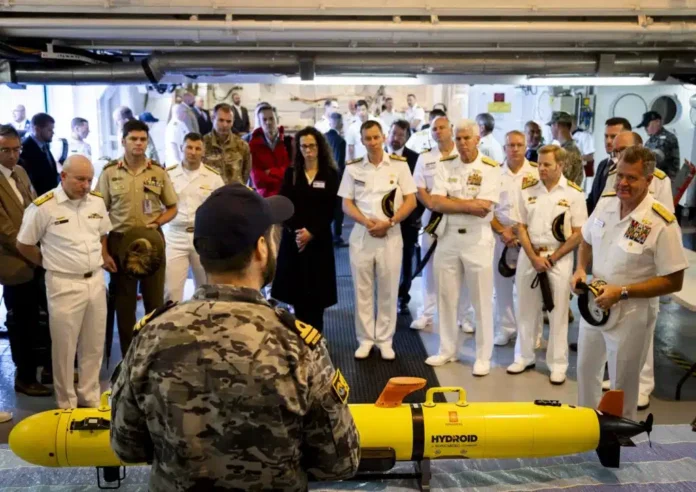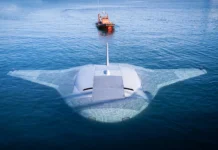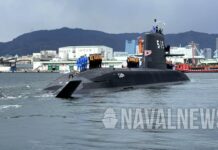
Details have been set out for four workstrands being developed, within Pillar 2 of the AUKUS trilateral strategic defence and security partnership, to generate new underwater battlespace capability for the Australian, UK, and US navies. One new capability priority is capacity to launch and recover uncrewed underwater vehicles (UUVs) from submarine torpedo tubes, Navy News reports.
Australia, the UK, and the US formally announced the AUKUS accord in September 2021. Two focus areas have been declared to date, named Pillar 1 and Pillar 2. Pillar 1 encompasses development and delivery of a nuclear-powered attack submarine (SSN) for the Royal Australian Navy (RAN) and the UK Royal Navy (RN), using the SSN-AUKUS design being developed under the RN’s lead.
Pillar 2 focuses on developing a range of capabilities to further enhance combined interoperability between AUKUS members. Pillar 2’s coverage continues to expand, and currently includes artificial intelligence (AI), cyber, electronic warfare, hypersonic, information-sharing, innovation, quantum, and underwater capabilities.
Speaking at the Undersea Defence Technology (UDT) exposition, held at London’s ExCel exhibition centre in early April, the RN’s Commodore Andy Perks – outgoing Deputy Director for Underwater Battlespace Capability in the RN’s Develop Directorate – said that each of the nine capability areas is being developed under a separate working group.
Within the underwater battlespace working group, he added, four workstrands are currently underway.
First is the development of an interchangeable UUV, to be launched and recovered from a submarine torpedo tube – what is known as a TTL&R capability.
Cdre Perks explained that work is based around the Leidos/L3Harris Iver4 autonomous underwater vehicle (AUV). Within the TTL&R capability development process, Cdre Perks underlined the emphasis on the recovery element. However, while this element is technologically challenging, he stressed that using a UUV is a good way to deploy a lot of capability from a submarine.
Rear Admiral James Parkin – the RN’s Director Develop – told the UDT conference in his keynote address that the TTL&R capability, which will be delivered for the RN under Project Scylla, can be fitted to any submarine and removes a boat’s need to surface to recover a vehicle.
“It gives an SSN its own offboard system,” said Rear Adm Parkin.
The submarine will be able to deploy a UUV, and then adapt how it uses the UUV, without having to involve another platform, he added.
Dan Packer – AUKUS Director for the USN’s Commander Submarine Force, and a retired USN submarine commanding officer – underlined the operational importance of the UUV TTL&R system. With submarines looking to bring increased capability into a more challenging operational environment featuring shallower, contested waters, a TTL&R UUV will help preserve a submarine’s ordnance capacity, he said.
Cdre Perks added that the USN has already conducted TTL&R sea trials, with the RN set to follow suit.
In July 2023, L3Harris demonstrated the TTL&R capability, accomplishing what the company said in a statement was “a fully autonomous launch and recovery of an AUV from an underway submarine”, with the test demonstrating the development and integration of a homing and docking solution designed to enable the TTL&R process.
Once the TTL&R capability has been worked through, the aim is to be at a mature point in programme development where companies can be invited to propose payload ideas, said Cdre Perks. While the UUV is key to unlocking interchangeability, the payload is more critical than the UUV itself, he stressed.
The second underwater workstrand is the concept of using AI and machine learning (ML) to augment underwater acoustic data processing. Here, testing has already been conducted using a USN P-8A Poseidon maritime patrol aircraft (MPA). A cloud-based approach was set up to enable AI/ML analysts to use data algorithms to process data; the P-8A then drew on the information output.
Third, for critical underwater infrastructure (CUI) security, the AUKUS partners are looking at commonality in operations and processes, and improving understanding of each other’s capabilities. In November 2023, the three navies conducted the Integrated Battle Problem 23.3 exercise, out of the RAN’s Fleet Base East naval station, Garden Island, Sydney: AUVs were used in the exercise to monitor CUI, including seabed pipelines and cables.
Finally, the AUKUS partners are looking at interchangeability in underwater self-defence capability, including torpedoes, countermeasures, and other effectors.
While delivery of an SSN capability for the RAN and RN under AUKUS Pillar 1 is a longer-term programme, AUKUS Pillar 2 is set to meet the requirement to provide more tangible, targeted outputs in the nearer term to begin tackling new challenges to the global order that are unfolding almost daily, said Cdre Perks.


